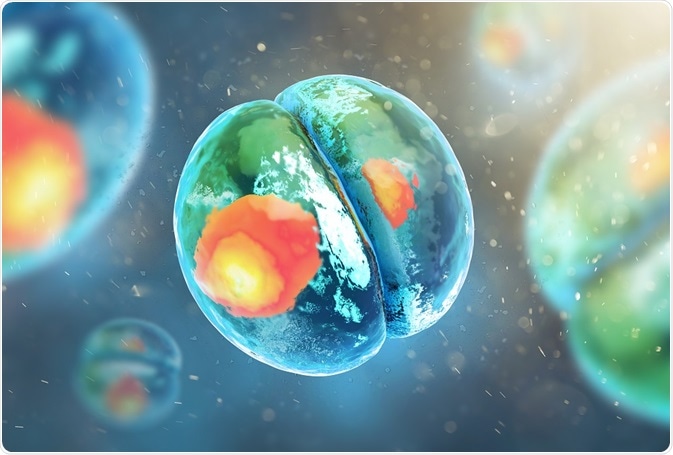The cell cycle is regulated by cyclins, a type of protein that binds and activates cyclin dependent kinases (CDKs).
 Image Credit: Andrii Vodolazhskyi / Shutterstock
Image Credit: Andrii Vodolazhskyi / Shutterstock
An introduction to cyclins
The accurate transmission of genetic information from a cell to a daughter cell is ensured by the tight regulation of the four stages of the cell cycle. The stages of this cycle include: Gap 1 (G1) phase, DNA synthesis (S) phase, gap 2 (G2) phase, and mitosis (M) phase. For each phase, there is a corresponding group of cyclins: G1 cyclins, G1/S cyclins, S cyclins and M cyclins, each with a different function.
The levels of these cyclins oscillate throughout the cycle with dramatically different levels at each stage. G1 is unusual as it is required at most stages and therefore it is present in high levels through the majority of the cycle. However, the other cyclin levels rise and fall when they are required.
This oscillation is due to a balance between gene expression and protein degradation via the ubiquitin-proteasome pathway. When a cyclin is required, levels of gene expression are raised leading to increased protein production. However, once the function of the cyclin is complete, the Skp Cullin F-box containing (SCF) complex or the anaphase promoting complex (APC) adds ubiquitins onto the cyclin via ubiquitinoylation, targeting it for degradation by the proteasome.
Discovery of Cyclins
Cyclins were discovered by Timothy Hunt, Leland H. Hartwell and Paul M Nurse, who found that the concentration of each cyclin was different at each stage and changed in a cyclical fashion. They won a Nobel prize in 2001 for their contribution to Physiology and Medicine.
The function of cyclins in the cell cycle
Cyclins have no enzymatic function of their own, and instead bind to CDKs to activate them. Once bound, they form maturation promoting factors which can phosphorylate target proteins and lead to the many different stages of the cell cycle.
As previously described, G1 cyclins are unusual as they do not oscillate. Instead their levels increase throughout the cycle, regulating cellular growth.
G1/S cyclins oscillate with a peak in between late G1 and early S phase. Once bound to CDKs, they begin to stimulate S phase CDK activity by preventing their inhibition, thereby stimulating the beginning of DNA and centrosome replication.
S cyclins are involved in the induction of DNA replication and early stages of mitosis. Their levels rise at the beginning of S phase and fall in early mitosis. Finally, M cyclins increase in mitosis and fall once the cell has passed the spindle formation checkpoint. They aid the formation of spindles and chromosome alignment on the metaphase plate.
The substrates of cyclin/CDK complexes
Once bound, the complex functions to phosphorylate many different target proteins. One of the most well studied is the retinoblastoma tumour suppressor (Rb).
Cyclin D bound to CDK4/6 phosphorylates this Rb protein, which usually inhibits transcription factor E2F. Therefore, in the presence of cyclin D, transcription factor E2F can transcribe proteins involved in progression into S phase, including the G1/S phase cyclins E and A.
Another example of a target protein is the phosphorylation of p27, which usually functions to inhibit Rb. Phosphorylation by CDK-2-cyclin E complex prevents this inhibition and so progression from G1 to S phase can continue.
Overall, cyclins are responsible for the progression of the cell cycle, ensuring that the important stages of each phase are carried out before the cell progresses into the next phase. Their discovery has since led to many other insights into the cell cycle, including insights into the function of cell cycle regulation in cancer.
Cell cycle checkpoints and regulation Animation
Further Reading